
Click Energy provides high feed-in tariffs — If your inverter is 5kW or less.
If you:
- want a high solar feed-in tariff.
- have a solar inverter 5 kilowatts or less.
- have low grid electricity consumption
…then Click Energy may be the best choice of electricity retailer to minimize your electricity bills (or maximize credit received).
This is thanks to Click Energy having the highest feed-in tariffs for new solar installations I know of. Unfortunately, what they charge for grid electricity is on the high side, so if your grid consumption is high and/or solar exports low you’re likely to find a better deal elsewhere.
To indicate if Click’s high feed-in tariffs are likely to be a good deal for you, I’ve crunched numbers for every capital city where they are available.
Available Locations
You can only choose Click Energy as your electricity retailer if you live in the following exciting locations:
- New South Wales
- Victoria
- South Australia
- South East Queensland (The part that’s mostly non-fatal.)
While this includes almost all Australians who swelter under the tyranny of retailer choice, it leaves out the ACT. No doubt because Canberrans just aren’t exciting enough. (Sure, they’re interesting, but they ain’t no Radelaidians. Sadly, they’re not even as thrilling as Stradbroke Islandarians.)
Our Electricity Plan Comparison Tool Has A Problem
Normally I’d just use the SolarQuotes Electricity Retailer Comparison tool to determine what the best deal for a solar household is. Unfortunately, the little internet elves that used to provide it with information are no longer in action.
Note from Finn: We reached out to AEMO/Energy Made Easy via multiple channels and people to ask for a direct feed. They ignored every single communication. We reached out to a private data feed provider who quoted us $10k per year for a replacement feed. That seemed like a fair deal – until we saw the contract. The contract said the data-feed provider would have a veto on any application of the feed we were paying for. The provider said they would not allow us to use the data feed for our free, non-monetised electricity plan comparison tool. So we are building our own data feed. Which is a stupidly big job. Please bear with us.
While the information it presents should still be nearly all up to date I can’t be certain it’s accurate, so I’ll work out how much benefit a Click Energy plan will provide by hand.
Comparison Capitals
I’ll investigate the benefits of a Click Energy plan in every capital they’re available:
- Adelaide
- Brisbane
- Melbourne
- Sydney
I’ll let you decide for yourself if I’ve arranged these cities by alphabetical order or how awesome their inhabitants are.
Household Characteristics
I’ll determine what a reasonably typical household’s annual electricity bill will be in each capital under a Click Energy plan and compare it to the best alternative I can find. To keep things simple I’ll just consider plans with standard tariffs that charge a flat rate per kilowatt-hour of grid electricity.
For my comparison household I’ve chosen a solar system size and total annual electricity consumption that should be a good match for a Click Energy plan while still being fairly typical:
- 4,500 kilowatt-hours total annual electricity consumption.
- A 5 kilowatt solar inverter with 6.6 kilowatts of north-facing panels.
This much annual electricity consumption is fairly typical for smaller households, but may not apply for large families or those who have pools, electric cars, underfloor electric heating, or members who get too carried away with climate control.
A 6.6 kilowatt solar system is just short of the maximum panel capacity a 5 kilowatt inverter can have, which is the largest inverter capacity Click Energy allows. Because the panels face north they’ll generate the maximum amount of energy possible.
Solar Self Consumption
Solar self-consumption is how much solar energy the household consumes itself and I’ll consider two different scenarios — medium and low. I’ll look at medium self-consumption because it represents a typical household, but I’ll also specifically look at low self-consumption because I know a lot of people who are out of their home for most of the day believe electricity plans with the highest feed-in tariff are likely to be the best for them and I want to check if this is true.
Medium Solar Self Consumption: A typical household consuming around 4,500 kilowatt-hours of electricity in total per year can expect to self consume around 20% of the energy a 6.6 kilowatt solar system with north-facing panels produces. I’ll use this figure for Adelaide, Brisbane, and Sydney, but I’ll bump it up to 22% for Melbourne as lower solar generation there tends to increase self-consumption.
Medium self-consumption can represent a home where there are often people around during the day but which is still left empty for considerable stretches of time. Or it could be a home where people are usually out for most of the day but a significant effort has been made to shift electricity consumption to the daytime. For example, timers have been used to switch on water systems, pool filters, and potentially other devices during the day.
Low Solar Self Consumption: This represents a home where people are usually out during the day without a great deal of effort made to shift consumption to the daytime. I’ll assume the household uses 10% of solar energy generated except in Melbourne, where I’ll use 11%. Because more solar energy is being exported under this condition it will give Click’s high feed-in tariffs an opportunity to shine. But because it also results in higher grid consumption, Click Energy’s high per kilowatt-hour charges will take a toll. Unless you’re some sort of mathematical genius it’s not really possible to tell without crunching the numbers.
Results By City
After finding a city’s most appropriate Click Energy plan — all of which have a floral theme — I compared them to the best competing plan I could find and put the results below. Charges and feed-in tariffs are in cents and kWh stands for kilowatt-hour.
Adelaide
In Adelaide, Click Energy has two equally good plans — Flora and Flora Solar — and they went head to head with AGL Solar Savers. The two fighter’s vital statistics are:
- Click Flora Solar: Daily supply charge 101.64, kWh charge 36.52, Feed-in tariff 17 cents
- AGL Solar Savers: Daily supply Charge 88.43, kWh charge 37.73, Feed-in tariff 16 cents
Unlike in the other capitals, Click’s per kilowatt-hour charge is lower than the best alternative plan I could find for the household.
Adelaide: 20% Solar Self Consumption
With medium, 20% solar self-consumption, both plans end up in credit over a year, which means instead of paying money to the retailer they receive it. Of the two retailers Click Energy is the best and came out $64 ahead:
- Click Flora Solar: $145 Credit
- AGL Solar Savers: $81 Credit
Adelaide: 10% Solar Self Consumption
With low, 10% solar self-consumption neither plan is in credit but the annual cost of electricity is still very low, with Click Energy again coming out ahead. this time by $87:
- Click Energy Flora plan: $56
- AGL Solar Savers: $143
Brisbane
In Brisbane Click Flora Solar went up against AGL Solar Savers:
- Click Flora Solar: Daily supply charge 117.81, kWh charge 23.43, Feed-in tariff 12 cents
- AGL Solar Savers: Daily supply Charge 110.22, kWh charge 24.04, Feed-in tariff 15 cents
Brisbane: 20% Solar Self Consumption
Click Energy gets its clock cleaned as the AGL plan comes out well ahead in the medium 20% solar self-consumption scenario with a $266 lead:
- Click Energy Flora plan: $23 Credit
- AGL Solar Saver: $289 Credit
Brisbane: 10% Solar Self Consumption
AGL also comes out well ahead in the low 10% solar self-consumption scenario:
- Click Energy Flora plan: $98
- AGL Solar Saver: $193 Credit
Melbourne
In Melbourne the best Click Energy plan is Click Rose Solar, while the best alternative I could find is Origin Solar Boost:
- Click Rose Solar: Daily supply charge 114.08, kWh charge 30.91, Feed-in tariff 16 cents
- Origin Solar Boost: Daily supply charge 113.09, kWh charge 25.17, Feed-in tariff 14 cents
Melbourne: 22% Solar Self Consumption
With medium 22% solar self-consumption the results are nearly a tie, with the Click plan coming out ahead by just $4. If I’d used 20% solar self-consumption as in the other cities, Origin would have come out $2 ahead:
- Click Rose Solar: $11 Credit
- Origin Solar Boost: $7 Credit
Melbourne: 11% Solar Self Consumption
The Click Energy plan’s high per kilowatt-hour charge takes the blush off the rose and allows Origin to win by $35 over the course of a year in the low 11% solar self-consumption scenario:
- Click Rose Solar: $144
- Origin Solar Boost: $109
Sydney
Sydney’s best Click Energy plan is Click Flora and the most competitive alternative I found was AGL Residential Solar Savers:
- Click Flora: Daily supply charge 99, kWh charge 28.22, Feed-in tariff 16 cents
- AGL Residential Solar Savers: Daily supply Charge 110.22, kWh charge 24.04, Feed-in tariff 15 cents
Sydney: 20% Solar Self Consumption
With medium 20% solar self-consumption the Click plan is a little ahead with $13 more credit:
- Click Flora: $173 Credit
- AGL Residential Solar Savers: $160 Credit
Sydney: 10% Solar Self Consumption
But with low 10% solar self-consumption, Click’s higher per kilowatt-hour charge for grid electricity allows the AGL plan to pull ahead:
- Click Flora: $54 Credit
- AGL Residential Solar Savers: $72 Credit
The Right Electricity Plan For The Right Situation
If we put the results into a little chart showing how far ahead or behind Click Energy came, it looks like this:
We can see that — with a solar power system of the maximum size allowed by Click Energy — a Click plan can be a good choice in Adelaide, a bad choice in Brisbane, and may be a good choice in Melbourne and Sydney. Because of Click’s high daily supply charge and high per kilowatt-hour charge, it is important that grid consumption be low enough in relation to exports to allow Click Energy high feed-in tariffs make their plans worthwhile.

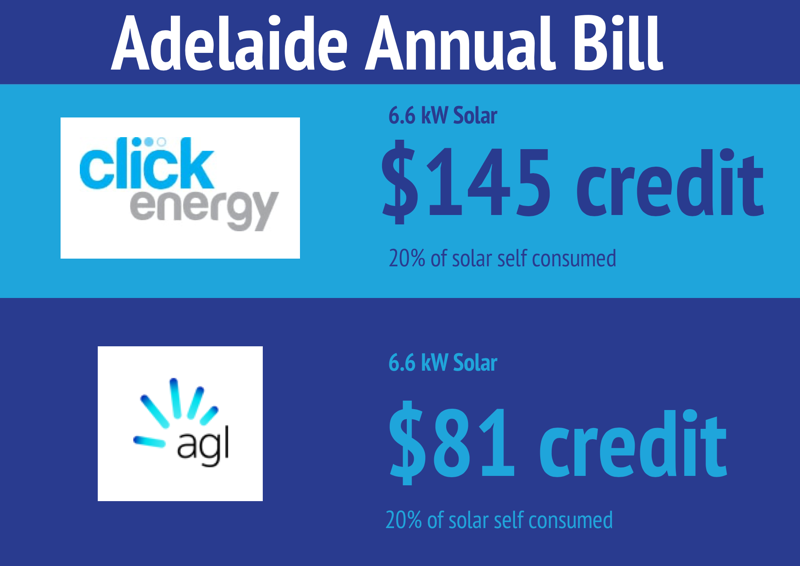
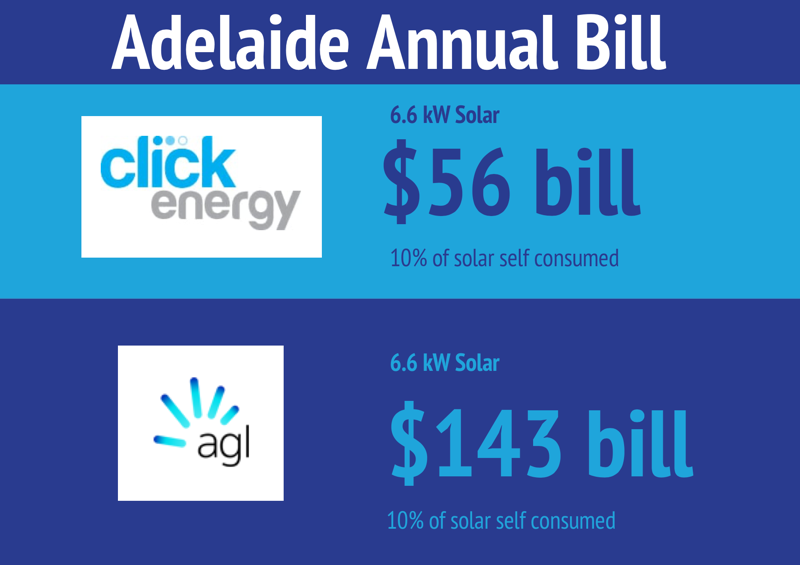
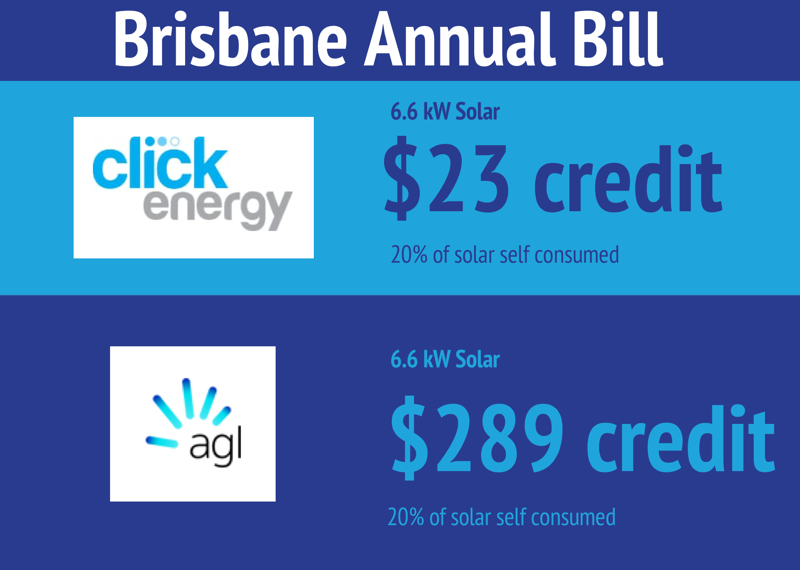
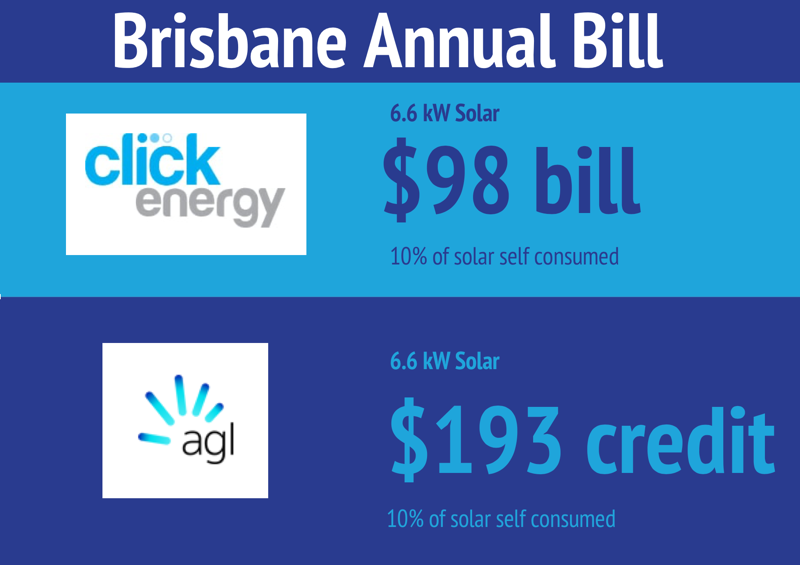
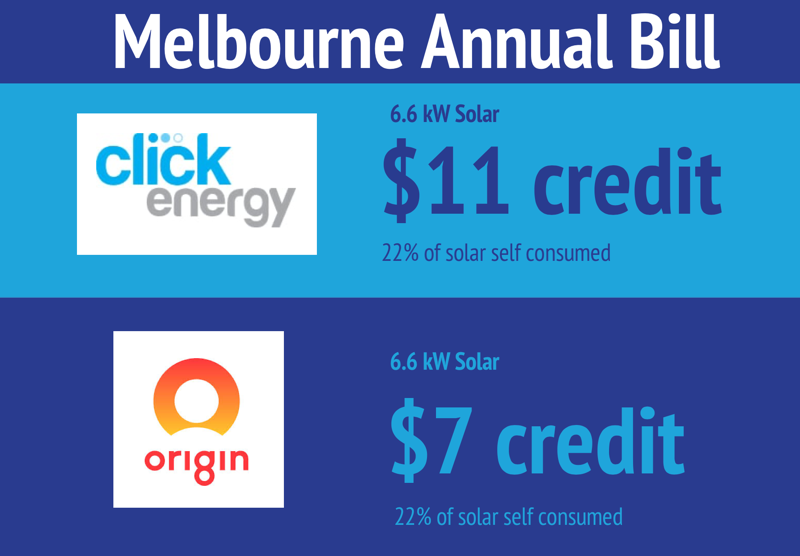
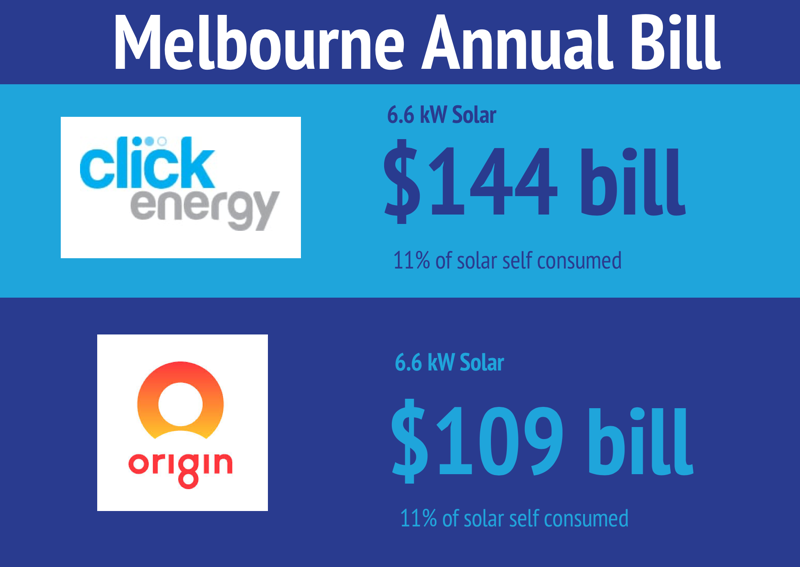
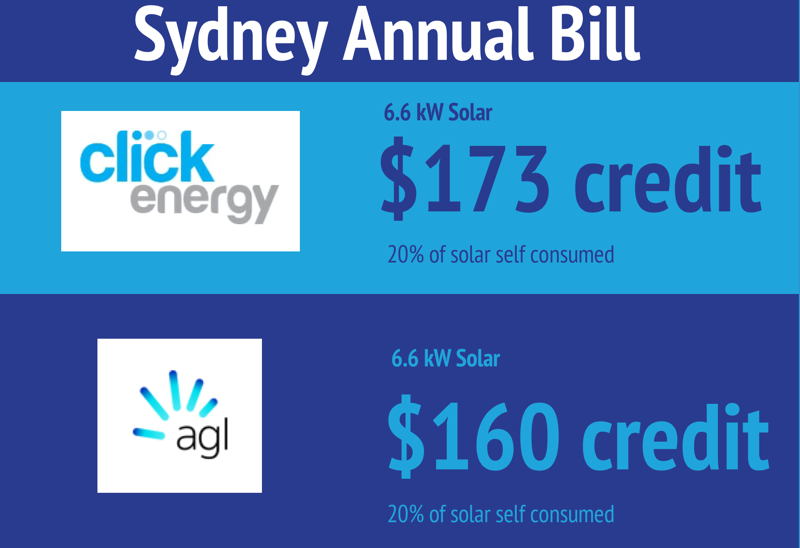
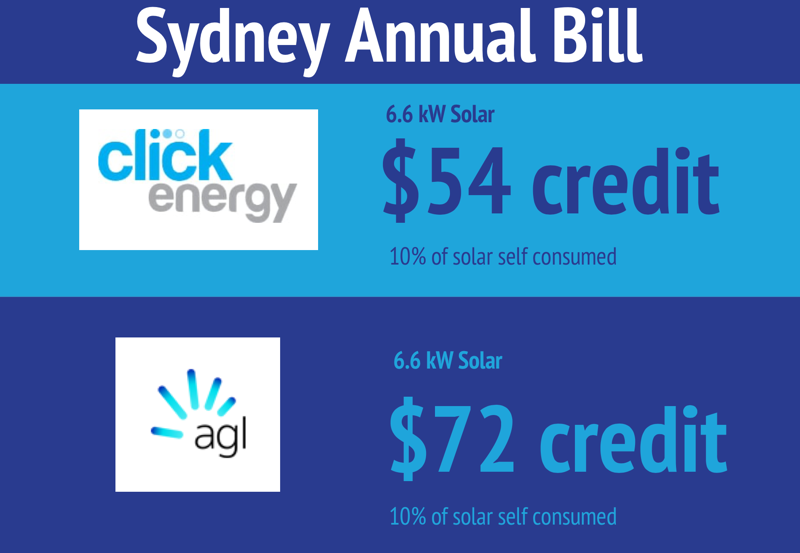

 RSS - Posts
RSS - Posts



Click has worked out very well for me. Been on the 80 cents/kWh PFIT plan in Victoria and they’ve paid out thousands of dollars in cheques.
Will be interesting to see if it changes now that AGL has bought them up.
Thanks Ronald. I’ve spotted a small typo. You wrote 7 cents when it should be 17 cents for the Adelaide Click Flora Solar plan as per here: https://www.energymadeeasy.gov.au/plan?id=CLI151235MRE1&postcode=5000
i.e.:
Currently:
Click Flora Solar: Daily supply charge 101.64, kWh charge 36.52, Feed-in tariff 7 cents
It should be:
Click Flora Solar: Daily supply charge 101.64, kWh charge 36.52, Feed-in tariff 17 cents
It wasn’t my mistake! I didn’t do it, honest! It was someone else!
But I kindly thank you for pointing the mistake out, which has now been fixed — while in no way accepting any responsibility what-so-ever.
Still getting 21c/KWh from Origin.
They rang to offer to continue it for another year (from October) after I threatened to change retailers when the contract was up. Up until then Click looked ok until you read their fine print which showed they paid 17c/KWh fit but only for the first 9KWh then it reverted to 9c. AGL was next best.
Still pay too much for the daily charge – 1.51 v around 1.00 in the city. Not fair when we are generating electricity in rural areas saving on long distance transport from power stations. Export far more than we import so the daily charge and cost of imports isn’t a factor (within reason).
Also not fair that they are prepared to pay 21c but won’t advertise it.
This has always been Origin’s MO. Been with them for years, and every year I do the “Energy Plan Tantrum”. It starts when I research the best advertised deal, which is invariably better than what Origin will give me after my current plan expires.
I ring Origin to ask them to match it, “Sorry Sir, that’s all I’m authorised to offer you”. OK, I’ll just sign on with an alternative energy provider for a better deal. Origin calls me back: “Hold on Sir, turns out we CAN offer you a better deal, just stay with us.” Offer lasts for 12 months…
Every. Freakin’. Year.
Just signed on with Origin again for their 21c/kWh FIT. Prior to installation of panels, I did the same silly game with them looking for the cheapest peak usage rates.
Had the same experience. Worth going through if you export much more than you import.
I suppose it had to happen eventually but AGL are dropping my FiT from 20c to 16c in Radelaide come January
I will need to enter the figures in my spreadsheet but I think the higher daily supply charge makes it line ball for my small system and very low consumption
Ring them,AGL extended my 20 cent tariff for two more years in August. I’am in Sydney.
Why are you bothering with an energy plan comparison tool anyway?
There are already a couple of good ones available and which cover all plan types, unlike your comparison tool which only looks at Anytime plans and as a result isn’t particularly useful.
Click in adelaide is the worst service I have ever received in Australia. They took months to connect my house to the grid and repeatedly blamed other groups. Only wheni threatened to take legal action did they low and behold arrive at the door the next morning. Our bills from them were extreme. If you miss a payment they will chase you down every single day for payment and are ruthless about it even when you explain that you are refusing to pay as they have taken months to allow the fees in tariff to work. Their customer service team speak broken English, are extremely rude and unable to fix the most basic of issues. Then when I got solar they tool months to allow the feed in to start working. This was during peak solar time during the summer. They are absolutely shocking and I question if this article is paid advertising. Anyone considering them should read their rating productreview.com as it is very clear that I’m not a one off, I’m part of the majority to have had similar problems with them.
To add to this if you do go over to see their ratings on product review.com make sure to ignore all the 5 star ratings as they a reclearly paying people to put them up. Eg hundreds of 5 star reviews that all read very similar from accounts created in the last few days and their only review is click energy. Total scam of an energy group.
Origin are only giving12c now was 21c
On the north coast of NSW Origin they will offer you 21 if you threaten to leave them.
Thank you for the update. Although we are really committed to self consumption, we haven’t been nearly as energetic in checking the retailers’ offerings. What happened to Powershop in Melbourne? I’ll miss their exceptionally helpful customer service people.
I’m in Brisbane. My house has two phases. I installed a 5kw inverter on each with 6.5kw of panels on each. I’m now feeding in heaps of power but only getting 8c/kWh for it with AGL. Does anyone know if I could have the individual phases with different suppliers so I could set them up with different suppliers who run 5kw feed in caps?
I’m afraid it’s one property, one bill, and I don’t know any way around this. It sounds like you may be better off with a plan with a higher feed in tariff, but it will depend on your grid electricity consumption.
Last month: 1,498 kWh feed in, 202 kWh from grid. Best days 70kWh fed in. Pretty happy with that. Might not be as good when we start using the aircons more but still need a better feed in tariff. Hard to find one without these volume caps
I just started on AGL’s Residential Solar Savers, they’re giving me 17c/kWh from my 10 kW inverter (3 phase) feeding in ~50 kWh/day (over the first 3 days) with no cap. Just hope they manage to fix the involuntary demand price referred to in my other post below. Those getting 20c and above, or even who have got that in the past, lucky them! This AGL one is the best I could find.
I’ve heard of AGL offering some of their ex-customers 21c/kWh to return, or prevent them from switching to other providers. You need to actually sign on with another company before they do anything about it though. Origin does the same thing too (that’s who I’m with, and that’s how I got their best deal).
If Mark is truly exporting 7 times more than what he’s importing, High Feed-in Tariff is definitely worth chasing. Plans I know of at this time:
Reamped NSW: 21c/kWh (capped at first 5 kWh per day – rubbish)
Origin: 21c/kWh (Need them to chase you for them to offer it to you)
AGL: 17c/kWh (Best advertised offer I’ve seen)
Click: 16c/kWh (Not sure if it’s capped, but I’ve lots of poor reports about their service).
Dodo: 11.6 c/kWh
I signed up to click for my parents house about 3 weeks ago from being a powershop customer.
I note that they dont have an app and their website account portal still shows zero electricity stats.
So from a monitoring perspective it’s pretty poor.
I haven’t received a bill yet, so I can’t provide feedback on pricing.
Here in Victoria the energy deal you get depends on the distributor you are forced to use. People in the United distribution areas always get a better deal than those in Ausnet areas across all retailers which really sucks given you have no choice unless you move. I’m not sure if this is the same in other states?
Also it would be great if you could run another comparison for those with larger systems.
Dude, AGL *certainly* come out on top in Qld if you’ve got a 10kW inverter! But what’s with the demand tariff that the (insert swearword here) distributor in SE Qld have arbitrarily now put on my meter at the moment I switched to them??? I certainly didn’t “opt in”!!! To their credit AGL is trying to fix it…
I have been placed on demand by our friends at Energex as well as of monday.
Unfortunately if you read their policy statements, all smart meters on energex will be transitioned to demand by July 1 2021. Mine was migrated as soon as i got a smart meter for my solar….
So even if AGL fix it for you, it’ll only be until July. They offered to fix it for me if i paid $100 or so. Our house is now learning a whole new way of living between 4pm and 9pm, the oven pre-heat is a killer…
Energex are smashing the value on solar at the moment. Demand + recent lowering of the voltages for volt-var response, despite no effort to actually lower the grid operating voltage… The worst part is it is all being done sneaky, under the radar. AGL didnt even know about the demand change until earlier this week, despite it apparently being policy since July.
I e changed to AGL solar saver. Now they can pay me $100 per month instead of $50
Ronald
AGL in NSW is offering $1000 off a battery purchase as an incentive to join their Virtual Power Plant. Sounds like a good idea. I presume this will make money for AGL but I’m not sure it stacks up for the initial outlay of the battery. Could you please investigate and evaluate the fine print of the deal.